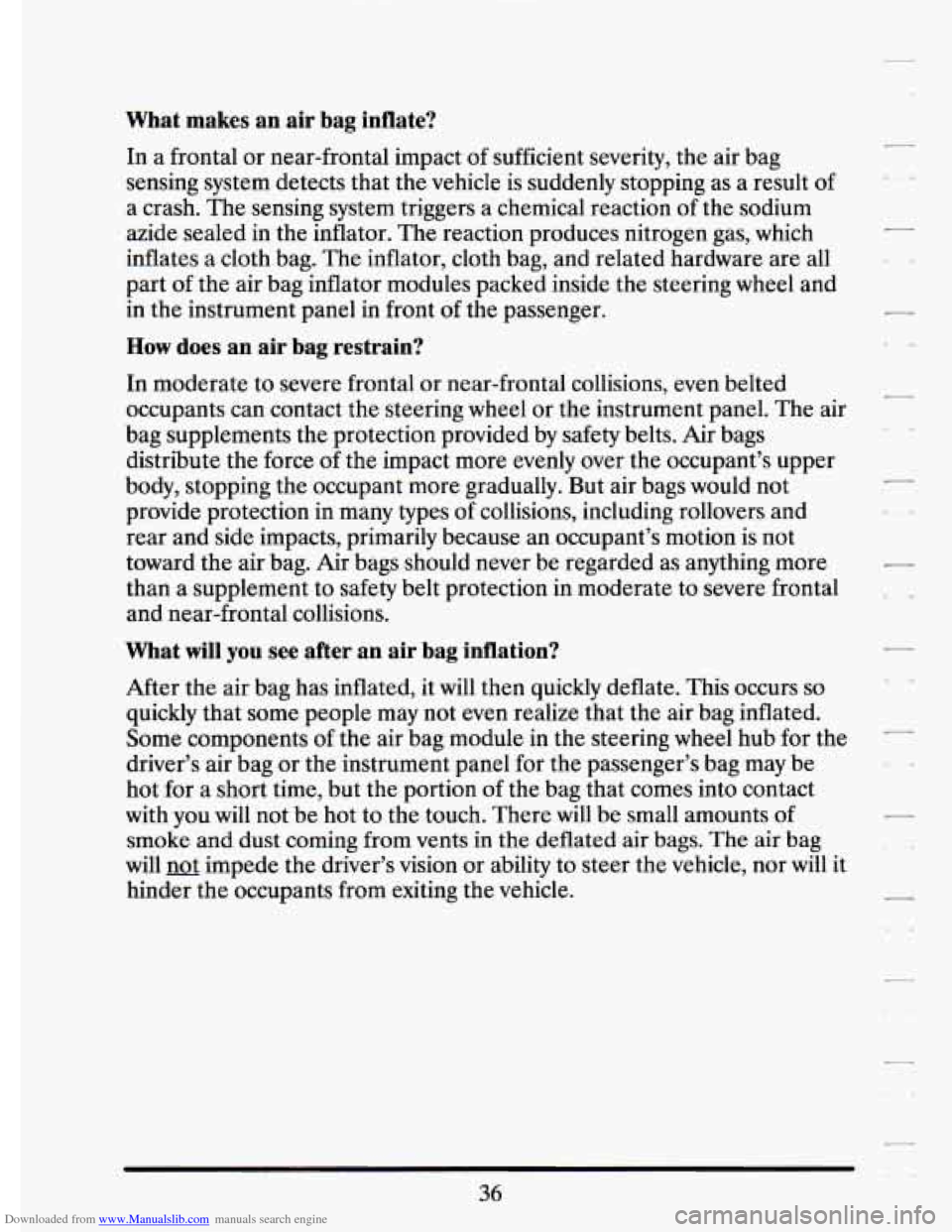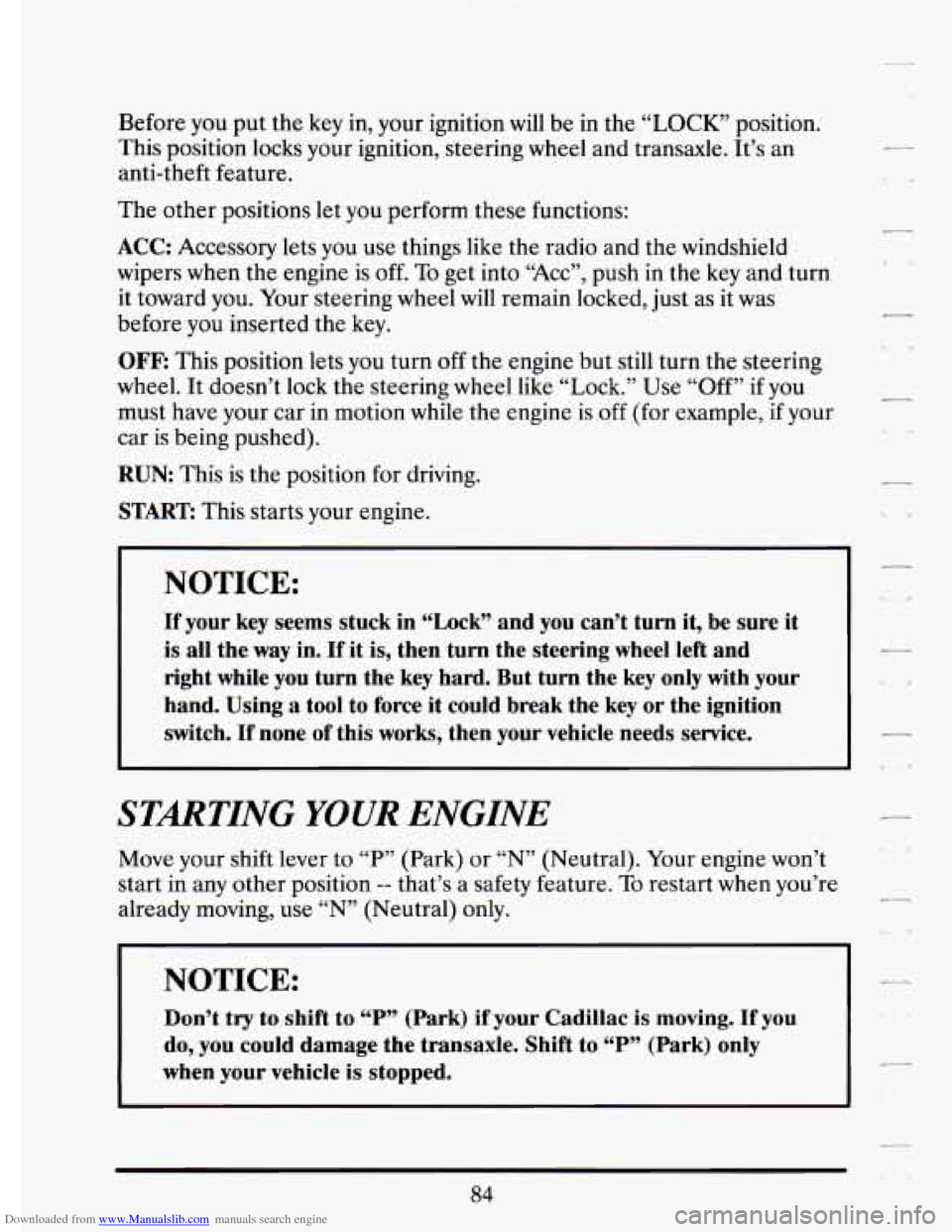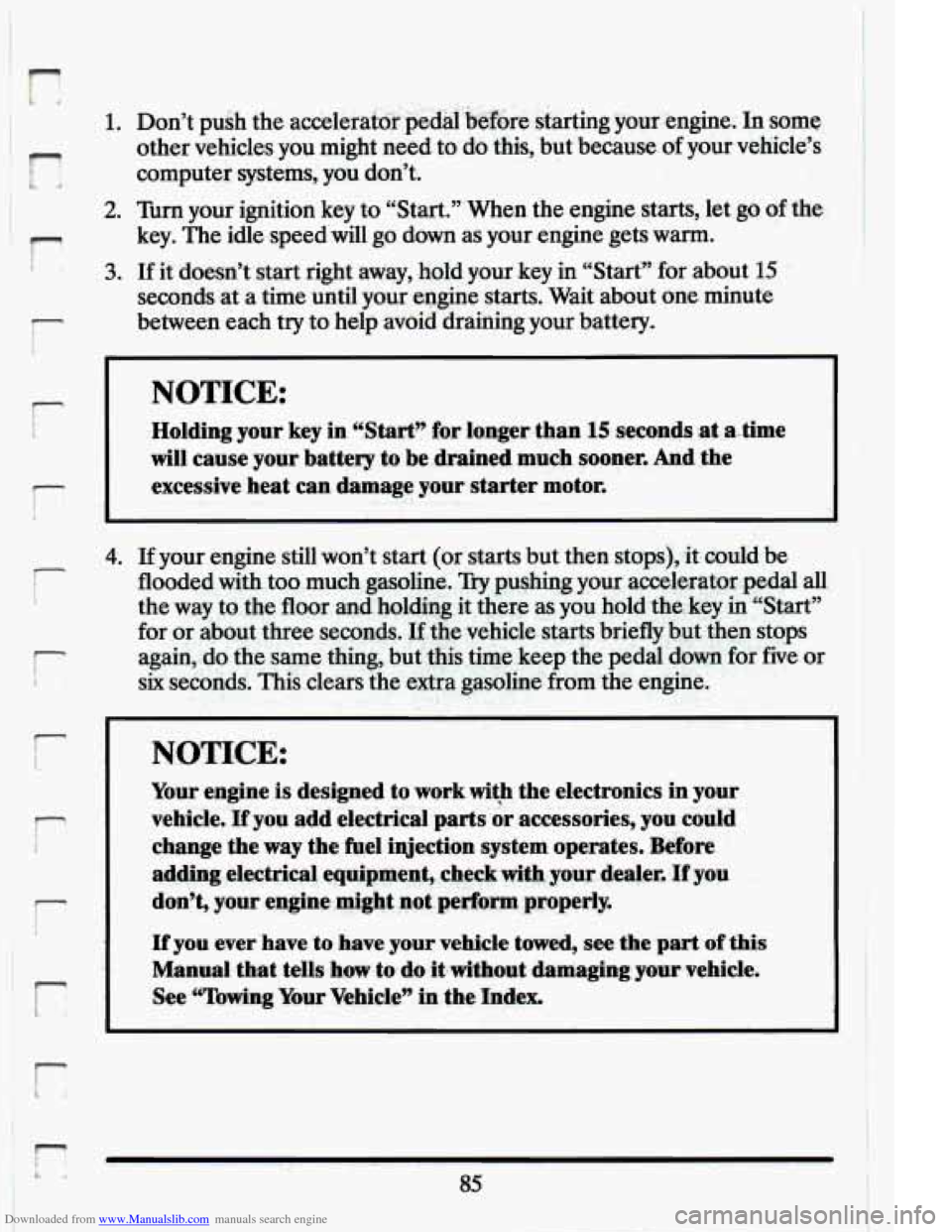Page 24 of 398
Downloaded from www.Manualslib.com manuals search engine Seatback Latches
The front seatback folds forward to let people get into the back seat.
Your seatback
will move back and forth freely, unless you come to a
sudden stop. Then it
will lock in place.
To fold the seatback forward after the seatback has locked, push the
seatback toward the rear as you
lift the latch on the back of the seatback.
Then the seatback
will fold forward. The latch must be down for the seat
to work properly.
The seatbacks
will lock when your parked going down a fairly steep hill.
The seatback
will also lock if the seat is positioned where the seatback is
straight up, with the front portion of the cushion full down, and the rear
portion is
in a full up position.
F
--
12
LC
Page 48 of 398

Downloaded from www.Manualslib.com manuals search engine What makes an air bag inflate?
In a frontal or near-frontal impact of sufficient severity, the air bag
sensing system detects that the vehicle is suddenly stopping as\
a result of
a crash. The sensing system triggers a chemical reaction of the sodium
azide sealed
in the inflator. The reaction produces nitrogen gas, which
inflates a cloth bag. The inflator, cloth bag, and related hardware are all
part
of the air bag inflator modules packed inside the steering wheel and
in the instrument panel in front of the passenger.
How does an air bag restrain?
In moderate to severe frontal or near-frontal collisions, even belted
occupants can contact the steering wheel or the instrument panel. The air
bag supplements the protection provided by safety belts. Air bags
distribute the force of the impact more evenly over the occupant’s upper
body, stopping the occupant more gradually. But air bags would not
provide protection in many types
of collisions, including rollovers and
rear and side impacts, primarily because an occupant’s motion is \
not
toward the air bag. Air bags should never be regarded as anything more
than a supplement to safety belt protection
in moderate to severe frontal
and near-frontal collisions.
What will you see after an air bag inflation?
After the air bag has inflated, it will then quickly deflate. This occur\
s so
quickly that some people may not even realize that the air bag inflated.
Some components of the air bag module
in the steering wheel hub for the
driver’s air bag or the instrument panel for the passenger’s bag may be
hot for a short time, but the portion of the bag that comes into contact
with you will not be hot to the touch. There will be small amounts of
smoke and dust coming from vents in the
deflated air bags. The air bag
will
not impede the driver’s vision or ability to steer the vehicle, nor will it
hinder the occupants from exiting the vehicle.
36
Page 74 of 398
Downloaded from www.Manualslib.com manuals search engine .*-
Q: What if a child is wearing a lap-shoulder belt, but the child is so
small that the shoulder belt is very close to the child’s face or neck?
A: Move the child toward the center of the vehicle, but be sure that the
shoulder belt still is on the child’s shoulder,
so that in a crash the
child’s upper body would have the restraint that belts provide.
If the
child is
so small that the shoulder belt is still very close to the child’s
face or neck, you might want to place the child in the center seat
position, the one that has only a lap belt.
7
t-4
c
62
Page 96 of 398

Downloaded from www.Manualslib.com manuals search engine Before you put the key In, your ignition will be in the “LOCK” position.
This position locks your ignition, steering
wheel and transaxle. It’s an
anti-theft feature.
The other positions let
you perform these functions:
ACC: Accessory lets you use things like the radio and the windshield
wipers when the engine is off. To get into “ACC”, push
in the key and turn
it toward you. Your steering wheel
will remain locked, just as it was-
before you inserted the key.
OFF: This position lets you turn off the engine but still turn the steering
wheel. It doesn’t lock the steering wheel like “Lock.” Use “Off”
if you
must have your car in motion while the engine is off (for example, if your
car is being pushed).
RUN This is the position for driving.
STARR This starts your engine.
NOTICE:
If your key seems stuck in “Lock” and you can’t turn it, be sure it
is
all the way in. If it is, then turn the steering wheel left and
right while you turn the key hard. But turn the key only with your
hand. Using
a tool to force it could break the key or the ignition
switch. If none of this works, then your vehicle needs service.
STARTING YOUR ENGINE
Move your shift lever to “P” (Park) or “N” (Neutral). Your engine won’t
start in any other position
-- that’s a safety feature. To restart when you’re
already moving, use
“N” (Neutral) only.
.-
,.
NOTICE: -
Don’t try to shift to “P” (Park) if your Cadillac is moving. If you
I
do, you could damage the transaxle. Shift to “P” (Park) only
when your vehicle
is stopped.
84
Page 97 of 398

Downloaded from www.Manualslib.com manuals search engine r
r
i
I- i
i
r i
2. ?iun your ignition key to “Start.”’When the engine starts, kt go of the
key. The idle ,speed’will go down as your engine gets warm.
3. If it. doesn’t start right away, hold your key in “Start” for about 15 .
secondsat a time until your engine starts. Wait about one minute
between each try to help avoid draining your battery.
NOTICE:
.Holding your key in ‘4S.talrtn €or longer: than .15 seconds -at a. time
will cause your battery to,be drained much sooner. And ‘the
excessive heat can damage your starter motor.
NOTICE:
Your engine is designed to work with the electronics in your
vehicle.
If you add electrical parts ‘or accessories, you .could
change the
way the fuel iqjection system operates. Befwe
-adding de,c#rical equ:ipm&, check with,pur.dealer, :If you
don’t, your engine.might
not pedhn properly.
Lf you ever’have to have your vehicle towed, see $he part of this
Mamud ,that tells ‘how to do itwi@hout damaging- your ,vehicle.
See-‘6Towing. Your Vehicle”
in the hdex,
. _“
Page 102 of 398
Downloaded from www.Manualslib.com manuals search engine N (Neutral)
In this position, your engine doesn’t connect with the wheels. To
restart when you’re already moving, use “N” (Neutral) only. Also, use
“N” when your vehicle is being towed.
NOTICE:
Damage to your transaxle caused by shifting out of “P” (Park)
or “N” (Neutral) with the engine racing isn’t covered\
by your
warranty.
0 @ Automatic Overdrive
This position is for normal driving. If you need more power for
passing, and you’re:
- Going less than about 35 mph (56 kmh), push your accelerator
- Going about 35 mph (56 km/h) or more, push the accelerator all
pedal about
halfway down.
the way down.
You’ll shift
down to the next gear and have more power.
90
Page 103 of 398

Downloaded from www.Manualslib.com manuals search engine tf
r
I.
NOTICE:
If your vehicle seems to start up rather slowly, or if it seems not
to shift gears
as you go faster, something may be wrong with a
transaxle system sensor. If you drive very far that way, your
vehicle can be damaged.
So, if this happens, have pour vehicle
serviced right
away Until then, you can use “2” (Second Gear)
when you are driving less than
35 mph (56 h/h) and @)
(Overdrive) for higher speeds.
F 1, 3 (Third Gear)
This is like
@, but you never go into Overdrive.
Here are some times you might choose
“3” instead of @:
- When driving on hilly, winding roads
- When towing a trailer, so there is less shifting.between gears
- When going down a steep hill
2 (Second Gear)
This position gives you more power but lower fuel economy. You can
use
“2” on hills. It can help control your speed as you go down steep
mountain roads, but then you would also want
to use your brakes off
and on.
r NOTICE:
Don’t drive in (‘2” (Second Gear) for more than 5 miles (8 km),
or at speeds overS5 mph (88 km/h), or you can damage your
transaxle.
Use “@)” or c63” as much as possible.
Don’t shift into
“2” u.nless you are going slower than 65 mph
(105 Wh), or you can damage your engine.
91
Page 106 of 398
Downloaded from www.Manualslib.com manuals search engine If you are towinr a trailer and are parking on any hill: See “Towing a
Trailer” in the Index. That section shows what to do first to keep the
trailer from moving.
SHIFTING INTO “P9’ (PARK)
Steering Column ShijZ Lever
1. Hold the brake pedal down with your right foot.
94